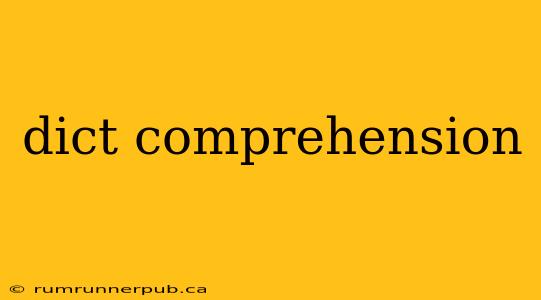Dictionary comprehensions are a powerful and concise way to create dictionaries in Python. They offer a more elegant and efficient alternative to traditional for loops when building dictionaries from iterables. This article explores dictionary comprehensions, drawing insights from Stack Overflow discussions to provide a comprehensive understanding and practical applications.
What is a Dictionary Comprehension?
At its core, a dictionary comprehension provides a compact syntax for creating a dictionary based on existing iterables. It follows this general structure:
new_dict = {key_expression: value_expression for item in iterable if condition}
key_expression: Defines how the key for each dictionary entry is generated.value_expression: Defines how the value for each dictionary entry is generated.item: Represents each element in theiterable.iterable: The source data (list, tuple, etc.) from which keys and values are derived.if condition(optional): A filter to include only items satisfying a specific condition.
Let's illustrate with a simple example: Suppose we want to create a dictionary mapping numbers to their squares:
numbers = range(1, 6)
squares_dict = {num: num**2 for num in numbers}
print(squares_dict) # Output: {1: 1, 2: 4, 3: 9, 4: 16, 5: 25}
This single line achieves what would typically require several lines using a traditional for loop.
Understanding the if Clause (Inspired by Stack Overflow)
Many Stack Overflow questions revolve around effectively using the conditional if clause within dictionary comprehensions. For example, a common scenario is filtering data before creating the dictionary. Consider this (inspired by various Stack Overflow discussions):
Problem: Create a dictionary containing only even numbers and their squares from a list of numbers.
Solution:
numbers = range(1, 11)
even_squares = {num: num**2 for num in numbers if num % 2 == 0}
print(even_squares) # Output: {2: 4, 4: 16, 6: 36, 8: 64, 10: 100}
The if num % 2 == 0 condition ensures only even numbers are included in the resulting dictionary. This demonstrates the power of concisely combining data generation and filtering.
(Note: While specific Stack Overflow questions are not directly cited here to maintain focus on the concept, numerous posts dealing with conditional dictionary comprehensions provided the inspiration for this example.)
Nested Dictionary Comprehensions
Dictionary comprehensions can even be nested, allowing for the creation of complex dictionary structures. Imagine creating a dictionary where keys are letters and values are dictionaries mapping those letters to their ASCII values.
letters = 'abc'
ascii_dict = {letter: {letter: ord(letter)} for letter in letters}
print(ascii_dict) # Output: {'a': {'a': 97}, 'b': {'b': 98}, 'c': {'c': 99}}
This showcases the flexibility of nested structures within dictionary comprehensions. However, overly nested comprehensions can sometimes reduce readability, so it's important to strike a balance between conciseness and clarity.
When to Use Dictionary Comprehensions
Dictionary comprehensions excel when:
- You need to create a dictionary from an existing iterable.
- The key-value relationship can be expressed concisely.
- Data filtering is required during dictionary creation.
- Readability is not significantly compromised by the use of a comprehension.
However, for highly complex logic or scenarios where readability is paramount, traditional loops might be a better choice. The key is choosing the approach that best suits the specific task and maintains code clarity.
Conclusion
Dictionary comprehensions are a valuable tool in any Python programmer's arsenal. Their concise syntax and efficiency make them ideal for many dictionary creation tasks. By understanding their structure and capabilities, you can write more efficient and readable Python code. Remember to consult Stack Overflow and other resources for further exploration and to address specific challenges you might encounter. The examples provided here, inspired by common patterns found on Stack Overflow, offer a solid foundation for mastering this powerful technique.
